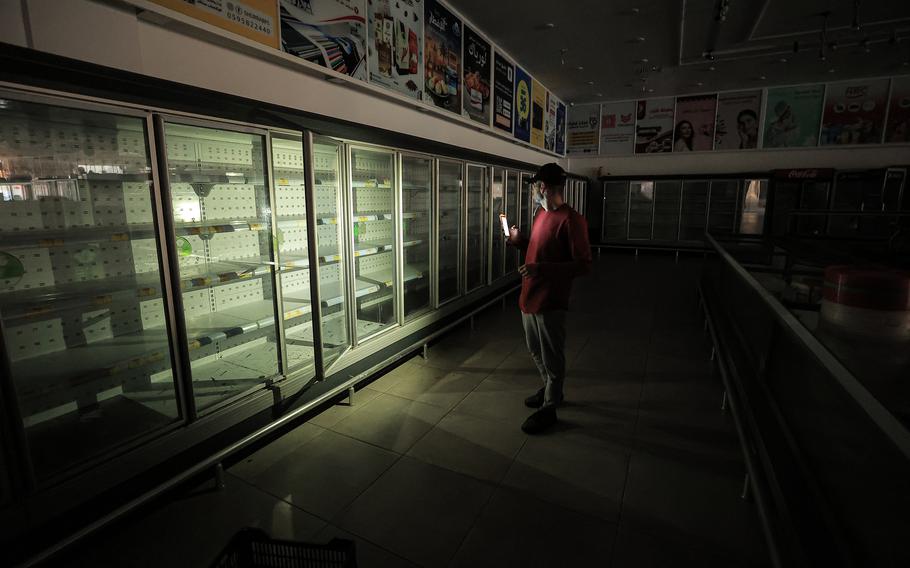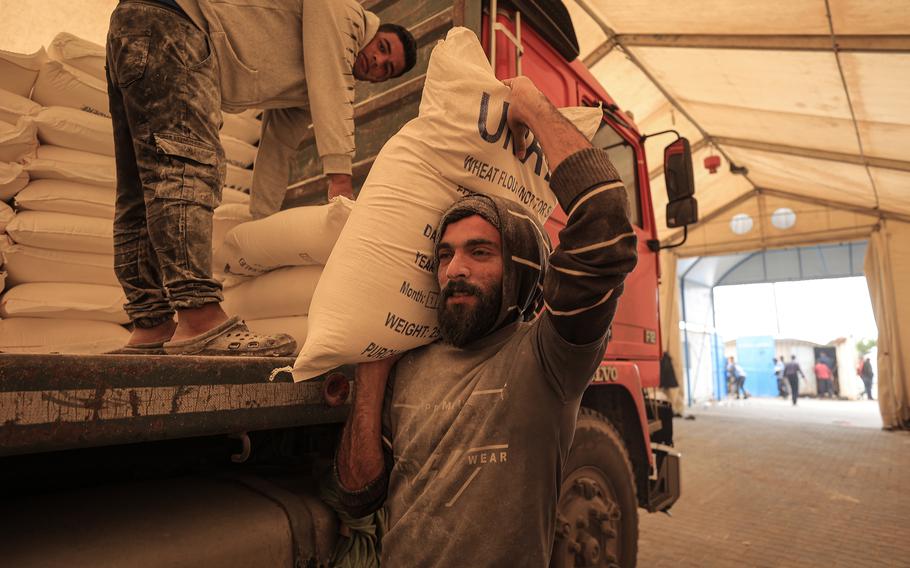
A man inspect empty shelves in a closed supermarket in Khan Younis in the southern Gaza Strip on Nov. 30. (Loay Ayyoub for The Washington Post)
JERUSALEM — Days into a humanitarian pause that has allowed more aid deliveries to the Gaza Strip, the population remains at “risk of famine and starvation,” the World Food Program warned this week, an alarming assessment by the U.N. agency of conditions in the besieged enclave that’s grown increasingly reliant on food aid nearly two months into what’s expected to be a protracted war.
Since Friday, when the brief halt in Israel’s military campaign quieted the skies over Gaza for the first time since Oct. 7, trucks packed with flour, date bars and canned beans have trickled in through the Rafah crossing with Egypt. Vegetables, freshly harvested or retrieved from storage, reappeared on shelves.
But the stomachs of Gazans of all classes are still rumbling, they and others told The Washington Post. Parents go hungry to feed children who still need more. Food prices have soared. Fights have broken out in long aid lines. Begging is a new norm.
“What is entering Gaza currently is not enough to meet people’s needs and avert the risk of starvation,” Alia Zaki, a spokeswoman for the World Food Program in Jerusalem, said Wednesday. “Without continued, scaled-up and sustainable safe access, and without fuel and connectivity, all humanitarian operations remain at risk.”
In the north, where Israeli troops are deployed and delivering aid is most difficult, Gazans have foraged amid the wreckage of war for anything they can eat: vegetables and fruits, canned meats and beans left behind.
Israeli strikes and ground operations have destroyed much of Gaza’s agricultural land as the winter season begins, compounding shortages and leaving the population of 2.3 million people with little prospect of being able to feed itself in the months to come.
“On many days of this war, we all survive on just one meal, often consisting of a few small pieces of bread or a small amount of rice, if someone donates to us,” said Saed Abu Dan, a father of 5-year-old twins, sheltering in the al-Aqsa Martyrs hospital in central Gaza.
He’s boiled bath water over burning plastic bags to cook macaroni, he said. He understood the dangers, “but my children ate it because there was no escape from hunger.”
When Hamas and other gunmen attacked Israeli towns on Oct. 7, farmer Yasser Hnaideq, 32, was growing peaches, apples, oranges and grapes in the southern Gaza city of Khan Younis. In Israel’s subsequent military campaign to eradicate the militant group, his fields have been destroyed. When he tried to return to them, he said, Israeli forces shot at him.
“In this war, whoever did not die from shells and missiles will die from hunger,” he said.

A man hefts a 25-kilogram bag of flour at a relief station where UNRWA, the U.N. agency for Palestinian affairs, distributes supplies. (Loay Ayyoub for The Washington Post)
Even before the war, more than two-thirds of Palestinians in Gaza were struggling daily to find food, according to the World Food Program, and about three-fourths of the population relied on food aid distributed by UNRWA, the U.N. agency for Palestinian affairs.
Shortages were driven by a blockade led by Israel and Egypt after Hamas took power in 2007. Israel controls all but one crossing into the enclave. It restricted food imports and largely banned exports.
As Gaza deteriorated, Palestinians accused Hamas leaders of living large.
Environmental, health and political crises worsened conditions. War has damaged croplands. Most of Gaza’s water is undrinkable. Without consistent electricity, sewage goes untreated and seeps into soils and wells. The scale of “de-development,” the United Nations has warned, made Gaza “unlivable.”
But the enclave has effectively collapsed since Israel imposed a complete siege on Oct. 9, shutting borders and cutting off electricity.
Two days earlier, Hamas raided Israeli towns near Gaza, killing more than 1,200 people and taking 240 more as hostages. Israel’s military campaign has caused more than 13,300 deaths in the enclave, the Gaza Health Ministry said last week. It has said it can no longer feasibly maintain the count.
The pause, in which Israel has agreed to stop attacking Gaza and release some Palestinian prisoners to get its hostages back, guarantees about 200 aid trucks enter Gaza daily. That’s the most since the war began, though less than half the prewar daily average of 500.
Those trucks have carried in 2,000 metric tons of World Food Program aid, including flour, fortified biscuits and a nutrient paste for pregnant women, Zaki said. The agency has prioritized calorie-dense foods that don’t need to be cooked. Before the pause, it mainly distributed wheat flour and canned tuna from existing local stocks. Since Friday, the World Food Program has delivered food to more than 120,000 people, covering about 10% of prewar needs, according to Zaki.
Ongoing fuel shortages are hindering distribution. Bakeries in Gaza have closed for want of fuel and flour, according to Abdul Nasser al-Ajrami, chairman of the Gaza Bakeries Association. UNRWA has prioritized giving bags of flour directly to families, UNRWA spokeswoman Tamara al-Rifai said. Of the 29 bakeries in Gaza with which the World Food Program works, only one is working, and then only occasionally.
“You cannot make 2.2 million people entirely dependent on humanitarian aid and food assistance,” al-Rifai said. “There has to be other options.”
Most Palestinians in Gaza, however, were already reliant on UNRWA before the war. About two-thirds are refugees, descended from the Palestinians expelled in the 1948 Arab-Israeli War. Before the latest conflict with Hamas, registered refugees received packages of staples such as tahina, powdered milk and tuna. During previous wars, Gazans sought shelter in U.N.-run schools and facilities, sites that were relatively safer from strikes and where basic food and water were available.
This war, there’s been little to go around but hunger.
UNRWA is sheltering nearly 1 million people in 99 facilities in southern Gaza. But frustration with the agency is growing.
Ahmed, a father of three, fled to a U.N. storage facility in Rafah expecting to find the necessities. “There’s not even bread,” he told The Post by phone, just canned tuna and highly processed cheese.
Before the war, his wife cooked hearty Gazan specialties such as sayadieh, a turnover fish and rice dish, and daqqa, a spicy tomato salad.
As desperation rises, fights have broken out in bread lines. In late October, thousands of people raided a U.N. facility in Deir al-Balah for flour and other supplies.
Other Gazans are trying to help.
Hani Abu Musa, 37, volunteers daily in central Gaza, cooking several thousand meals of rice, meat, legumes and beans for people displaced by the fighting. During the weeks of bombardments, his crew snuck to border areas at night to retrieve livestock from abandoned farms.
The influx of food aid during the pause has helped, he said, but it’s “not enough for the huge numbers of people, in addition to the scarcity of raw materials.” Food prices have doubled. Gazans use firewood instead of cooking gas. The water is often unclean, putting people at risk.
Israel’s “targeting of agricultural lands along the border strip of the Gaza Strip, from Beit Hanoun in the north to Rafah in the south, also affected our ability to obtain the vegetables needed to help prepare meals,” he said.
Some of these vegetables have started to reappear in markets, along with nonperishable items that traders could retrieve from storage once the strikes stopped.
Akram Abu Khousa never used to go hungry.
The farmer has acres in the northern Gaza community of Beit Lahiya. Life wasn’t easy: Past conflicts damaged his fields, his sector suffered under the blockade and many farmers fell into debt. But he was proud to produce food for Gaza.
“I never worked with the Tanzim,” he said, referring to Hamas fighters. “My work is a farmer. But today everyone is targeted.”
After nearly two months of war, Abu Khousa is rationing flour and canned foods among 200 family members crammed into the Nuseirat refugee camp in central Gaza. “Tomatoes, cucumbers are available,” he said. “But the prices are so expensive.”
Abu Khousa fled to southern Gaza after Israel warned Gazans to leave the north. In late October, his sons snuck back. They found their family house and fields wrecked. He estimated it would take three months to start farming — if the land can even bloom again.
Harb reported from London.